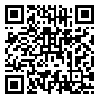1. Khankeh HR, Co-authors. [Disaster hospital preparedness: National plan (Persian)]. Tehran: University of Social Welfare and Rehabilitation; 2013.
2. Jassempour K, Shirazi K, Fararooei M, Shams M, Shirazi AR. The impact of educational intervention for providing disaster survival kit: Applying precaution adoption process model. International Journal of Disaster Risk Reduction. 2014; 10: 374-80. doi: 10.1016/j.ijdrr.2014.10.012 [
DOI:10.1016/j.ijdrr.2014.10.012]
3. EM-DAT. Preliminary data human impact of natural disasters 2016 [Internet]. 2017 [Updated 2017 January 17]. Available From: Http://Www.emdat.be/Publications
4. CRED. Disasters in Numbers 2015 [Internet]. 2016 [Updated 2016 October 12]. Available From: Http://Www.emdat.be/Publications.
5. Ardalan A, Masoomi G, Goya M, Ghaffari M, Miadfar J, Sarvar M, et al. Disaster health management: Iran's progress and challenges. Iranian Journal of Public Health. 2009; 38(1):93-7.
6. Ghanbari V, Maddah S, Khankeh H, Karimloo M. [The effect of a disaster nursing education program on nurses' disasters preparedness for responding to probable natural (Persian)]. Iran Journal of Nursing. 2011; 24(73):72-80.
7. Khankeh HR, Khorasani-Zavareh D, Johanson E, Mohammadi R, Ahmadi F, Mohammadi R. Disaster health-related challenges and requirements: A grounded theory study in Iran. Prehospital and Disaster Medicine. 2011; 26(03):151–8. doi: 10.1017/s1049023x11006200 [
DOI:10.1017/S1049023X11006200]
8. Charney RL, Rebmann T, Esguerra CR, Lai CW, Dalawari P. Public perceptions of hospital responsibilities to those without medical Presenting injury or illness during a disaster. The Journal of Emergency Medicine. 2013; 45(4):578–84. doi: 10.1016/j.jemermed.2013.05.010 [
DOI:10.1016/j.jemermed.2013.05.010]
9. Djalali A, Castren M, Khankeh H, Gryth D, Radestad M, Öhlen G, et al. Hospital disaster preparedness as measured by functional capacity: A comparison between Iran and Sweden. Prehospital and Disaster Medicine. 2013; 28(05):454–61. doi: 10.1017/s1049023x13008807 [
DOI:10.1017/S1049023X13008807]
10. Saldana-Zorrilla SO. Assessment of disaster risk management in Mexico. Disaster Prevention and Management: An International Journal. 2015; 24(2):230–48. doi: 10.1108/dpm-11-2013-0201 [
DOI:10.1108/DPM-11-2013-0201]
11. Esfandiari A, Heidari A, Julaee H, Rahimi S, Salari H. Survey of natural disasters preparedness in public and private hospitals of Islamic Republic of Iran (case study of Shiraz, 2011). International Journal of Health System and Disaster Management. 2013; 1(1):26. doi: 10.4103/2347-9019.122441 [
DOI:10.4103/2347-9019.122441]
12. Ingrassia PL, Mangini M, Azzaretto M, Ciaramitaro I, Costa L, Burkle FM Jr, et al. Hospital disaster preparedness in Italy: a preliminary study utilizing the World Health Organization hospital emergency response evaluation toolkit. Minerva Anestesiologica. 2016; 82(12):1259-66. PMID: 27270072 [
PMID]
13. Aladhrai SA, Djalali A, Della Corte F, Alsabri M, El-Bakri NK, Ingrassia PL. Impact of the 2011 revolution on Hospital Disaster Preparedness in Yemen. Disaster medicine and public health preparedness. 2015; 9 (04): 396-402. [
DOI:10.1017/dmp.2015.30] [
PMID]
14. Qassemi F, Khankeh H, Delshad V, Hosseini M. The effects of implementing early warning system and activating the Imam Khomeini on the preparedness of Sari Hospital (RH) in disasters and incidents. Health in Emergencies and Disasters Quarterly. 2016; 2(1):19-24. doi: 10.18869/nrip.hdq.2.1.19 [
DOI:10.18869/nrip.hdq.2.1.19]
15. Khankeh HR, Mohammadi R, Ahmadi F. [Barriers and facilitators of health care services at the time of natural disasters (Persian)]. Archives of Rehabilitation. 2005; 6(1):23-30.
16. Khankeh HR, Mohammadi R, Ahmadi F, Maddah SB, Ranjbar M, Khodaei MR. [Management of health care services at time of natural disasters (Persian)]. Archives of Rehabilitation. 2006; 7(2):49-55.
17. Khankeh HR, Mohammadi R, Ahmadi F. [Health care services at time of natural disasters: A qualitative study (Persian)]. Iran Journal of Nursing. 2007; 20(51):85-96.
18. Bazregar R, Khankeh H, Ahmadi S, Hosseini M, Rahgozar M, Moradian M. [The evaluation of application of coordination model based disaster response in disaster Preparedness Rajaye hospital (Persian)]. Iranian Journal of Nursing Research. 2013; 29(8):10-118.
19. Karimiyan A, Khankeh H, Dalvandi A, Farzin Nia B. The effect of teaching principles of hospital preparedness according to the national program on preparedness of Shahid Motahari burns hospital of Tehran in response to disasters. Health in Emergencies and Disasters Quarterly. 2017; 2(1):25-32 [
DOI:10.18869/nrip.hdq.2.1.25]
20. Salevaty J, Khankeh H, Dalvandi A, Delshad V. The impact of nurses training and applying functional and nonstructural hospital safety in hospitals in disasters preparedness of razi and day based on hospital safety index. Health in Emergencies and Disasters Quarterly. 2015; 1(1):17-24
21. Khankeh H, Co-authors. [Risk assessment tools and indicators of surge capacity of health in disasters (Persian)]. Tehran: University of Social Welfare and Rehabilitation; 2016.
22. Karimian A. The effect of education based on national guideline on hospital disaster preparedness and response Burn martyr Motahari Hospital, Tehran to Disaster [MSc. thesis]. Tehran: University of Social Welfare and Rehabilitation; 2014.
23. Zaboli R, Sajadi HS. Assessing hospital disaster preparedness in Tehran: Lessons learned on disaster and mass casualty management system. International Journal of Health System and Disaster Management. 2014; 2(4):220-4. [
DOI:10.4103/2347-9019.144405]
24. Yousefi S. [National hospital preparedness and risk management and safty guidline on hospital staff preparedness assessment tool using simulation and national risk (Persian)] [MSc thesis]. Tehran: University of Social Welfare and Rehabilitation; 2017.
25. Delshad V, Borhani F, Khankeh H, Abbaszadeh A, Sabzalizadeh S, Moradian MJ, et al. The effect of activating early warning system on motahari hospital preparedness. Health in Emergencies and Disasters. 2015; 1(1):3-8.
26. Daneshmandi M, Amiri H, Vahedi M, Farshi M, Saghafi A, Zigheymat F. Assessing level of preparedness for confronting the crisis such as flood, earthquake, fire and storm in some selected hospitals of Iran. Iranian Journal of Military Medicine. 2010; 12(3):167-71.
27. Hosseini Shokouh SM, Arab M, Rahimi A, Rashidian A. Sadr Momtaz N. [Preparedness of the Iran University of Medical Sciences hospitals against earthquake (Persian)]. Journal of School of Public Health and Institute of Public Health Research. 2009; 6(3):61-77.

 , Hamid Reza Khankeh *2
, Hamid Reza Khankeh *2 
 , Vahid Delshad3
, Vahid Delshad3 
 , Mehdi Rahgozar4
, Mehdi Rahgozar4 
 , Narges Arsalani1
, Narges Arsalani1 
 , Farahnaz Mohammadi1
, Farahnaz Mohammadi1 







